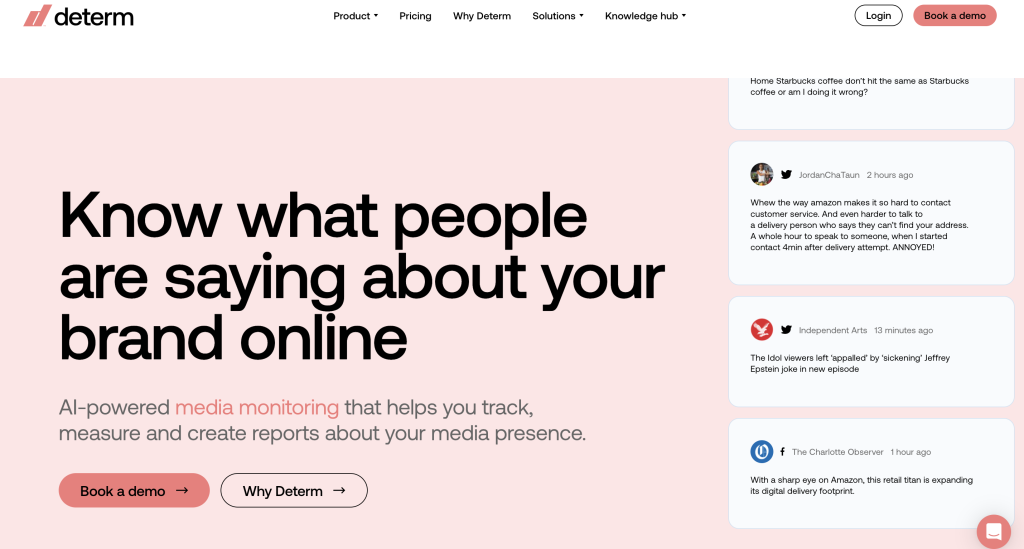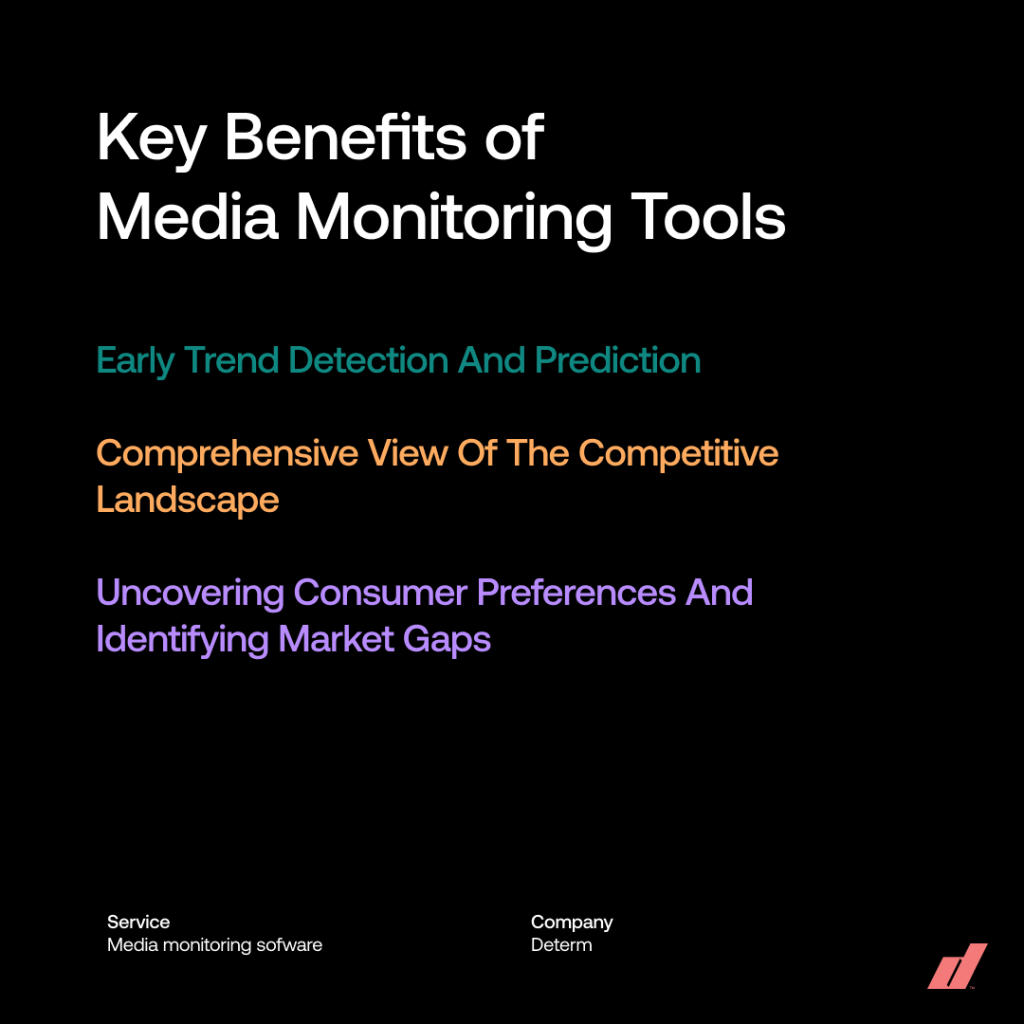Have you ever wondered how some companies seem to have a sixth sense when predicting industry trends? They effortlessly stay ahead of the curve, adapting their strategies to meet evolving customer needs and outmaneuvering their competition. Here’s a secret: they’re not relying on crystal balls or guesswork. They’re harnessing the power of media monitoring tools.
Picture this: the global media monitoring tools market, which was valued at $3.4 billion in 2021, is projected to skyrocket to a staggering $13.7 billion by 2031, growing at a remarkable compound annual growth rate (CAGR) of 15.1% from 2022 onwards. Certainly, these numbers speak volumes about media monitoring tools’ rising recognition and strategic value in today’s business landscape.
💡 Read Media Monitoring: The Ultimate Guide
This blog post will peel back the curtain and unveil the strategic potential of media monitoring tools for predicting industry trends. Whether a small startup or an established enterprise, understanding and leveraging these tools can give you a competitive edge that propels your business forward.
The Power of Industry Trends
In this section, we will delve into the significant role that industry trends play in shaping business strategies and why companies must anticipate and adapt actively. Additionally, we will explore how industry trends impact customer preferences, market demand, and the competitive landscape.
Shaping Business Strategies
Industry trends act as guiding forces that influence the direction and focus of business strategies. Furthermore, companies gain valuable insights into emerging patterns, consumer behavior, and market dynamics by closely monitoring and analyzing trends. This knowledge allows businesses to align their goals, product development, and marketing efforts with the changing demands of their target audience.
Impact on Customer Preferences
Industry trends provide valuable cues about evolving customer preferences. Forthwith, they reflect shifting consumer needs, desires, and expectations. By understanding and predicting industry trends, businesses can tailor their products and services to meet customer demands, resulting in higher customer satisfaction and loyalty.
Influence on Market Demand
Trends have a direct impact on market demand. As new technologies, social shifts, or cultural movements gain traction, consumer demand for related products or services increases. By recognizing these trends early on, businesses can capitalize on emerging opportunities, adapt their offerings, and gain a competitive advantage in the market.
Competitive Landscape
Industry trends also shape the competitive landscape. By all means, companies that successfully identify and respond to trends are better positioned to outperform their competitors. They can leverage trends to differentiate themselves, innovate, and stay ahead in a rapidly changing market. Failing to recognize and adapt to trends may lead to falling behind and losing market share.
Proactive Anticipation and Adaptation
Companies must proactively anticipate and adapt to industry trends to thrive in today’s dynamic business environment. This involves continually monitoring industry developments, analyzing data, and staying informed about emerging technologies, consumer preferences, and market shifts. By being proactive, businesses can seize opportunities, mitigate risks, and stay ahead of the curve.
The Challenges of Traditional Trend Analysis
This section will explore the limitations and challenges of relying solely on traditional surveys and market research methods to analyze industry trends. Markedly, we’ll discuss the potential biases, time lag in data collection and analysis, and the risk of missed opportunities that arise from these methods.
1. Limitations of Traditional Surveys and Market Research
Traditional surveys and market research methods have long been relied upon to gather insights about industry trends. However, these methods come with limitations. For instance, they often involve a limited sample size and may need to fully capture a target market’s diversity of opinions and preferences. Further, this can lead to incomplete or skewed data that accurately represents the broader consumer landscape.
Read Staying Ahead of the Game: Why Media Monitoring is Critical for PR and Marketing Agencies
2. Time Lag in Data Collection and Analysis
Traditional trend analysis methods typically involve time-consuming processes, such as designing surveys, administering them, and analyzing the collected data. This results in a significant time lag between data collection and obtaining actionable insights. By the time the analysis is complete, trends may have evolved or shifted, rendering the insights outdated and less impactful.
3. Potential Biases in Data Collection and Analysis
Another challenge with traditional methods is the potential for data collection and analysis biases. Surveys and market research often rely on self-reported data, which can be influenced by respondent bias or inaccurate recollection. Additionally, the interpretation of data can be subject to researcher biases, impacting the accuracy and reliability of the insights gained.

4. Risk of Missed Opportunities
Due to the inherent delays and potential biases associated with traditional trend analysis methods, businesses risk missing out on valuable opportunities. By the time insights are available, competitors may have already capitalized on emerging trends, leaving late adopters at a disadvantage. Delayed insights can hinder innovation, product development, and strategic decision-making, potentially resulting in missed market opportunities.
A Statistic to Include: According to recent studies, 51% of brands now incorporate social media monitoring into their marketing efforts. This statistic highlights the growing recognition of alternative methods, such as media monitoring, to gain real-time insights and overcome the challenges of traditional trend analysis.
Enter Media Monitoring Tools
We’ll explore their unique capabilities to collect real-time data from diverse sources, and their capacity to capture consumer sentiment, industry buzz, and emerging patterns.
Introducing Media Monitoring Tools as Game-Changers
Media monitoring tools are revolutionizing the way businesses analyze industry trends. These tools leverage advanced technologies and algorithms to sift through vast amounts of data in real time, providing invaluable insights that traditional methods struggle to deliver. By harnessing the power of media monitoring tools, businesses gain a competitive edge in staying ahead of the curve.
Determ Media Monitoring Tool: A Game-Changer for Businesses
- Real-Time Data Insights: Determ Media Monitoring Tool collects and analyzes data from various sources in real time. Generally, this lets businesses stay updated with the latest trends, news, and consumer sentiments, allowing quick and informed decision-making.
- Diverse Source Monitoring: Determ monitors various sources, including social media platforms, news websites, blogs, forums, and more. This ensures a comprehensive market view, capturing valuable insights from various channels and helping businesses uncover emerging patterns and opportunities.
- Advanced Sentiment Analysis: With its advanced sentiment analysis capabilities, Determ Media Monitoring Tool goes beyond data collection. It can understand and interpret consumer sentiments, giving businesses a deeper understanding of how their target audience feels about their products, services, or industry trends.
- Competitive Landscape Analysis: Determ helps businesses gain a competitive edge by providing insights into their competitors’ activities, strategies, and online presence. By monitoring competitor mentions, industry buzz, and customer feedback, businesses can adjust their own strategies to stay ahead of the competition.
- Customizable Dashboards and Reports: Determ offers customizable dashboards and reports, allowing businesses to visualize and track the data most relevant to their needs. This enables effective data analysis and reporting, facilitating data-driven decision-making within the organization.

Collecting Real-Time Data from Diverse Sources
One of the key strengths of media monitoring tools is their ability to collect data from diverse sources in real time. These sources include social media platforms, news outlets, blogs, and forums. By monitoring these channels, businesses can tap into up-to-the-minute information to track trends as they emerge and evolve.
Capturing Consumer Sentiment, Industry Buzz, and Emerging Patterns
Media monitoring tools go beyond collecting data; they also excel at capturing the pulse of consumer sentiment, industry buzz, and emerging patterns. These tools employ sentiment analysis techniques to gauge consumers’ feelings about specific products, brands, or trends. By understanding consumer sentiment, businesses can tailor their strategies to meet customer needs and expectations better.
Furthermore, media monitoring tools enable businesses to identify industry buzz, recognizing which topics, keywords, or discussions are gaining traction. This valuable insight helps companies position themselves effectively in the market and respond promptly to emerging trends or issues.
Read Top 5 Media Monitoring Metrics That Matter
Key Benefits of Media Monitoring Tools
This section will explore the key benefits of media monitoring tools, focusing on their ability to enable early trend detection and prediction, provide a comprehensive view of the competitive landscape, and uncover consumer preferences while identifying market gaps.

1. Early Trend Detection and Prediction
By enabling businesses in predicting industry trends, media monitoring tools empower them and provide a valuable advantage. These tools capture real-time data and identify emerging patterns and discussions by monitoring diverse sources such as social media, news platforms, blogs, and forums. This early insight enables businesses to adapt their strategies proactively, capitalize on opportunities, and stay ahead of the competition.
2. Comprehensive View of the Competitive Landscape
With media monitoring tools, businesses gain a comprehensive view of the competitive landscape. These tools monitor competitor activities, brand mentions, and industry buzz, providing valuable insights into competitor strategies, market positioning, and customer perceptions. By understanding the competitive landscape, businesses can refine their approaches, differentiate themselves, and identify areas for improvement.
3. Uncovering Consumer Preferences and Identifying Market Gaps
Media monitoring tools are crucial in uncovering consumer preferences and identifying market gaps. By analyzing conversations, sentiments, and feedback across different channels, these tools provide businesses with a deep understanding of consumer needs, desires, and pain points. This knowledge allows businesses to tailor their products, services, and marketing efforts to align with customer expectations and seize untapped market opportunities.
Read How to Use Media Monitoring to Boost Your Communication Strategy
Moreover, live chat and digital business cards have become increasingly important in the context of media monitoring tools. Live chat enables businesses to engage with customers in real time, addressing their topics, gathering feedback, and building relationships. Digital business cards are a convenient and shareable way to provide contact information and make connections, enhancing networking and lead-generation efforts.
Final Thoughts
In summary, media monitoring tools provide strategic value in predicting industry trends by enabling businesses to stay competitive and ahead of the curve. These tools offer early trend detection and prediction, a comprehensive view of the competitive landscape, and insights into consumer preferences and market gaps. By embracing media monitoring tools, businesses can make informed decisions, adapt their strategies, and capitalize on emerging opportunities.
To experience the benefits of media monitoring firsthand, we encourage you to book a demo for the Determ media monitoring tool. With real-time data insights, diverse source monitoring, advanced sentiment analysis, and customizable reporting capabilities, Determ can be a game-changer for your business.
Josef Mohamed is a Content Marketer, SEO strategist, and Web Designer who writes about Marketing, Technology, and other related topics. He founded Josefmohamed.com and Blissa.de, where he shares his knowledge and expertise.


